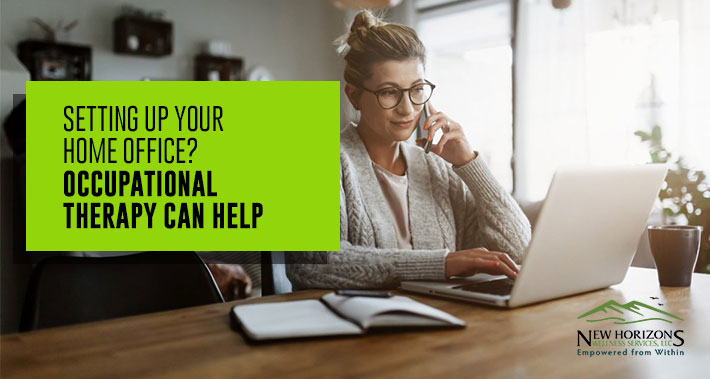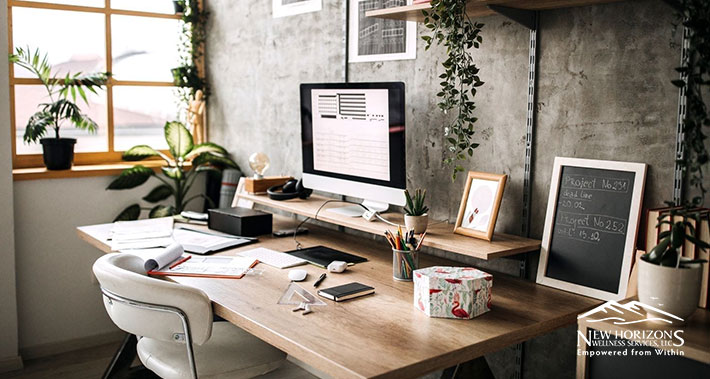
This year, around the world, millions of people have left their offices and set up shop at home.
Technology allows us to work remotely fairly easily, but most homes are designed for living and playing, not working.
Here at New Horizons Wellness Services, we provide occupational therapy for adults, which often includes optimizing working environments.
For example: it’s rare for people to have proper office chairs with the correct support at home.
However, working from the couch for long periods of time – or a kitchen chair – puts stress on your body.
To learn more, read on below.
What Is Occupational Therapy?
Occupational therapists help adults perform the various tasks of their daily life in a safe way.
Some of the conditions that occupational therapists help patients with include:
- The seat depth should support your thighs, and you should have about four inches between the back of your knees and the front of the seat.
- Your feet should be resting flat and comfortably on the floor.
- Armrests should be adjusted to lightly support your arms at a natural, ninety-degree angle.
- Adjust the lumbar support, or add towels.
- Make sure there’s no contact stress anywhere on your body from the chair, or add padding as needed.
- Make sure you get a chair on wheels so you can adjust your distance to your keyboard and monitor easily.
- Add a pillow to the seat for additional comfort.
We all have challenges, but an occupational therapist will work to find ways you can mitigate those challenges.
Occupational Therapy Tips For Your Home Office
Even if you’re an office worker, there’s a physical side to your job that may surprise you: sitting for hours on end.
You’d be shocked, the impact 8 hours of inactivity can have on your physiology and your mental health.
A 2015 study in the Annals of Internal Medicine found that prolonged sitting was deleterious to one’s health.
However, with some adjustments in furniture setup plus additional tips, we can help you achieve a more minimal impact.
1. Positioning Your Screen
Let’s get right to the nitty-gritty of it: your computer screen(s) that you spend so much time staring at.
There’s no getting around their use – we need them for our jobs, just as I’m using one now.
However, there are tips to moderate negative impacts of prolonged screen use.
Here are some guidelines for setting up your screen optimally:
Your screen should be elevated enough that your eyes are level with the top of the monitor – this helps prevent eye fatigue.
Laptops are definitely the toughest on the body, because it only truly works for either typing or viewing – but not both.
If you primarily work off a laptop, invest in a wireless keyboard and mouse so that you can still do your work with your screen set up at the correct height.
Your monitor should be roughly an arm’s length away from you, unless you’re using a laptop with a much smaller screen, in which case you’ll probably want to have it closer.
Tilt the monitor so that the bottom is closer to you – it will help your eyes focus better, especially if you wear progressive lenses.
2. Your Lighting Setup
As you probably are aware from your last Netflix binge, screen glare is the absolute worst.
With windows, be sure to neither face it nor have your back to it – instead, set up at a ninety-degree angle to the window.
If that isn’t possible, it might be worth getting some simple blinds or some nice new drapes to help with the glare.
Try to keep the overhead lights lower, and use a desk lamp over documents for easiest reading, instead.

3. Your Desk
The goal for keyboards is to have your elbows at a ninety-degree angle, meaning your desktop is almost in your lap.
This helps to keep your wrists in a neutral position, and keep blood flowing through your arms.
A very common problem is “wrist extension” – when wrists are bent up.
This is a common cause of carpal tunnel syndrome.
If you already have a work surface, but you realize it’s too high, you may need to replace your chair for one that is taller, or you may need cushions or a footstool to help.
Because most surfaces in a home are inappropriately high for typing, you’re also likely to suffer from contact stress.
You know how your laptop edge cuts into the underside of your arms, leaving little indents?
That’s contact stress – and it both restricts blood flow and compresses the soft tissues in your arm.
Wherever possible, try to find positions to reduce this, or add padding or wrist-wrests to guard against it.
Finally, your mouse: you’ll want to keep it as close to the keyboard as possible so you don’t stress your shoulder too much.
4. Your Chair
We talked above about updating your chair based on your desk, but in a perfect world, you’d do the reverse.
If you have a budget to spend on setting up your home office, I recommend starting with the chair, and building from there.
You want a chair that you can adjust until you are perfectly comfortable and properly supported.
• The seat depth should support your thighs, and you should have about four inches between the back of your knees and the front of the seat.
• Your feet should be resting flat and comfortably on the floor.
• Armrests should be adjusted to lightly support your arms at a natural, ninety-degree angle.
• Adjust the lumbar support, or add towels.
• Make sure there’s no contact stress anywhere on your body from the chair, or add padding as needed.
• Make sure you get a chair on wheels so you can adjust your distance to your keyboard and monitor easily.
• Add a pillow to the seat for additional comfort.
5. Other Tips
There are endless additional tips, and I am happy to go through all of them in our consultation.
To give you some ideas to take away today, here are some of my favorites.
Every twenty minutes, give your eyes a twenty second break – and set a timer so you don’t forget.
The aptly-named 20-20-20 rule says to choose something approximately 20 feet away to look at during those 20-second breaks.
If you’re working from home, it’s actually a great opportunity to take advantage of different locations so don’t get stuck in one position for eight hours.
You may be lucky enough to have a backyard patio set that you can take advantage of; an hour later, move to the couch, then the kitchen table, then back again.
It’s even better if you can set up a standing desk somewhere in your home so you can spend part of the day off your bum.
If you can manage it, and you don’t have any video conference calls, you can even pile up some pillows and enjoy a lounge in bed for a change – while you work, of course.
And never forget: move around when you can – take advantage of phone calls to pace around, or perhaps even while you go for a walk around the block.
Book An Appointment With New Horizons Wellness Services
I know that working from home can be challenging, so let’s take care of some low-hanging fruit and get you more comfortable.
Call now and book your appointment with New Horizons Wellness Services and we’ll have a look at your setup and help you with some easy solutions.
Every body is different – and so is each treatment plan we produce.
No matter what you’re dealing with or what your constraints are, we can help you find an easier way to work at home.
Yours in Health,
New Horizons Wellness Services13333 SW 68th Pkwy,
Tigard, OR 97223
- https://g.page/newhws
New Horizons Wellness Services provides a true multidisciplinary approach to mental & physical health treatments for children, adults and families.
